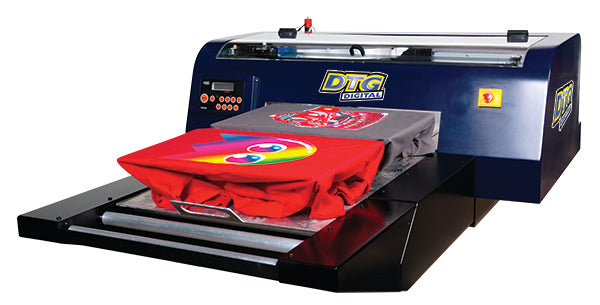
History of Direct to Garment Printing
Digital Printing Technology
Up until 2005 the only real option you had if you wanted to enter the printed shirt business was screen printing. Screen printing is a largely manual process that involves dragging ink across a porous “screen” with an image on it, transferring that ink to the garment below. But like the transition from large commercial printing and publishing companies to desktop publishing some decades earlier, the custom t-shirt business was in for a digital revolution.
The direct to garment printer industry in the United States seriously launched in late 2004 at the SGIA show in Minneapolis. At that show both Mimaki & U.S. Screen showed direct to garment printers for the first time – Mimaki with the GP-604 & U.S. Screen with the original Fast T-Jet (manufactured by Mastermind in Japan).
Early 2005 brought the first large traditional printer company into the marketplace as Brother introduced their GT-541 – a light shirt-only printing solution that eventually became the Brother Graffitee DTG Printer line.
Not long afterwards, October 2005, Kornit introduced their first machines – the Storm & Thunder. There price point kept them out of range of all but the biggest of custom t-shirt businesses with initial investments in the $200,000 to $250,000 range.
October 2005 also saw the introduction of the first DTG-brand direct to garment printer – the Kiosk – at the ITMA Asia show in Singapore. The Kiosk offered some important direct to garment specific enhancements over the other models in the price range, like automated head cleanings, a valve system to shut off specific ink channels and more user friendly ink chip resetting.
Direct to Dark Garment Printing
Up until the end of 2005 all of the t shirt printing machines on the market could only print on light garments because they did not have the ability to print white ink. Printing was restricted to light colors because when you print Yellow onto a black t-shirt, for example, you get this color – NOT yellow.
A radical change to the market came at the end of 2005 when U.S. Screen released white ink for their Fast T-Jet printers. Although the pretreatment process was VERY complex we were finally able to print on dark garments. That was possible because if you print a layer of white ink onto a black t-shirt for example, you can then print that yellow ink on top of it and get a true yellow color.
U.S. Screen sales of printers exploded and the direct to garment marketplace would never be the same again.
A year later the U.S. Screen exclusive on white ink expired and other vendors, like DTG Digital were given the opportunity to add white ink to their printers. At that time it became evident that changes were needed to manage the white ink which has radically different properties than the color inks (inorganic pigment vs. organic pigment). This led the DTG group to start formulating ideas of how to manage the white ink. The earliest example came on the DTG HM1. The white ink was contained in a single, large bottle which had a magnetic stir pill in it the stirred the white ink periodically to minimize settling. Not long afterwards the HM1 was upgraded to the HM1-C which replaced the stir pill with a circulation system (thus the “C”).
The DTG exclusive White Ink Management System was born – known by its acronym – WIMS. This invention helped to greatly reduce the maintenance issues that are associated with the settling of white ink.
Modern Direct to Garment Printers
In early 2009 the DTG Viper entered the market and set new standards for productivity. With its unique belt-fed system a shop could now setup a “print through” operation. This format was more conducive to efficiency, especially in shops where space was not a major concern. With the DTG designed 4-2-1 platen system a user was also able to produce multiple garments at one time without having to dedicate a huge amount of space to oversized printers.
DTG became More than just a passing fad.
Until this point all of the DTG brand direct to garment printers had been based on core Epson printers (in fact, most of the direct to garment printers had been). In late 2011 ColDesi unveiled the DTG M2 at the Fort Worth ISS Show. The M2 became the first DTG brand printer not to start its life as an Epson page printer. The M2 is a joint effort between DTG Digital and a large format printer manufacturer. Gone are the non-direct to garment errors & messages associated with re-purposed printers, no more ink chips & waste counters to reset. Clever engineering greatly increased the serviceability of the machine and a two across platen system nearly doubled productivity.
Large screen printers & fulfillment houses are now starting to incorporate DTG printing into their business. One large customer in Ohio runs 33 M2’s!
With the release of the M4 earlier this year players like Levi Strauss have jumped on the band wagon as well – doing oversized prints on items like blue jeans, beach towels and more.
Over the history of direct to garment printing and the custom t-shirt business, the DTG Brand has demonstrated its ability to innovate at the right pace, making sure service and support are there to back up new technology. More than 30% of our business are repeat customers; embroidery professionals buying DTG Printers, custom t-shirt shops expanding into rhinestone transfer machines and screen printers adding direct to garment for short runs.
The Viper also marked another step in the evolution of the DTG line; Not only was the WIMS system enhanced to now incorporate a stirrer in the white ink bottle as well as circulating the ink through the system – but the color ink system was now also pressurized to eliminate issues of ink flow during periods of heavy production.
